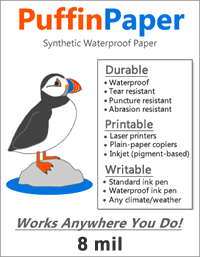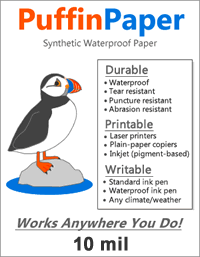What Type of Waterproof Printer Paper Should I Use?
Our first choice for outdoor printing is a laser printer. Why? Because they apply solid toner particles that enter pores in the paper and stay there. Some inkjet printers apply dye-based inks that can be mobilized when wet. No matter what type of printer you use, we always recommend applying a minimal amount of ink/toner. Best results are usually obtained by setting your printer to "economy", "draft", "light", or another setting to produce the lightest possible application of ink/toner.
8 mil Waterproof Paper | ||
 |
| |
10 mil Waterproof Paper | ||
 |
| |
Are these papers really "waterproof"?
These papers stand up well to rain and moisture. They are great for taking notes in wet weather and for use where your notes might be subject to contact with sweat, moisture or water. We placed a sheet of each of these papers underwater for one week, writing on them daily with a waterproof ink pen. They retained their integrity, accepting and retaining the ink. We continued the test for one month, writing on each paper at the end of each week. At the end of one month, all of the papers were still in good condition and continued to accept and retain ink.A standard ballpoint pen usually works well on these papers. But, we highly recommend using a pen with waterproof ink. Why buy waterproof paper and take chances with your ink? Soluble inks and gel pen inks can wash right off. Be sure to test your pen, printer and paper combination before going into the field or starting a project. It's not the performance of your paper that determines your level of protection - it is how your paper, writing implement and printing work together.
These products are intended for short-term outdoor use - they are thin pieces of plastic. If you need long-term exposure to water, a metal sign or a rigid plastic plaque is needed.
Avoid smearing and excess ink:
We recommend printing using the "light" or "draft" or "economy" settings of your printer. Printing in "high quality" or "dark" mode usually applies more ink than the paper can absorb. That will cause ink smearing or ink that does not dry. If the ink smears or does not dry in "normal" or "standard" mode, see if you can print with a "light" or "economy" mode. For best results use the lightest printer setting that produces readable print.When writing, a medium point pen works best. Broad-point pens or those that put down a thick layer of ink generally deposit excess ink that does not absorb into the paper and smears. Fine-point pens are sharp and can dig into the synthetic plastic papers when writing. Pens that leave behind blobs of ink when you write should be thrown away. They make a mess no matter where you write with them.
Use high-quality ink and toner!
Most people who use the ink or toner cartridges supplied by the manufacturer of their printer have great success with these papers. Refilled cartridges and generic cartridges frequently provide poor results because they contain low-quality inks, low-quality toner, or water-soluble inks. For best performance, use quality inks provided by your printer manufacturer.Exposure to sun, wind, rain, wine, spaghetti sauce, dishwashers, dogs and bullets...
Keep in mind that you are buying a product that is a thin plastic sheet. It will last outside for a few weeks (more or less), depending upon climate and sun exposure. It is not dog-proof or bullet-proof. It will not last through repeated or prolonged exposures to hot, cold, sun, wind, or other harsh conditions. This is why highway departments use metal signs, and the military uses metal dog tags. "Paper" is inexpensive and easy-to-use and perfect for some situations - but it might not be the material best suited for the conditions of your project.- SUN EXPOSURE: Ink is usually the first thing to fail during outdoor use. It can quickly fade in the sun. Red and yellow ink are usually the first to fade. Depending upon location and exposure, an outdoor sign might last a few days to a few weeks in bright, direct sunlight before the ink fades. The paper will eventually break down if exposed to the UV rays of direct sunlight for long periods of time. Lots of people use our papers for yard sale signs, outdoor notices, and other documents that will be in the bright sun for a few days to a few weeks, with good results. We do not recommend them for long-term outdoor use. You need a metal sign.
- SPAGHETTI SAUCE / WINE: We don't recommend our papers for use as menus and cookbooks unless they are laminated. These papers like to absorb color, and they will be stained by wine, spaghetti sauce, coffee, and any other moist material with color. Of the papers that we sell, PuffinPaper performs best with lamination. It is a microporous synthetic paper that binds with the laminating film so that it resists separation much better than standard paper.
- COLD AND HEAT: Of the papers that we sell, PuffinPaper has been tested to perform under the widest temperature range. It remains pliable and writable at temperatures from -70°C / -94°F to 180°C / 356°F. The temperature at which your pen or your body can function will limit your work before the paper does. Other papers can have narrower ranges of temperature performance. They can become brittle in very cold weather. They might soften if you attach them to a hot billboard in direct sun. We don't recommend them for use in very hot or very cold situations.
- DISHWASHERS: The papers that we sell are meant to be used in environments where humans work and play. That does not include the interior of a dishwasher where they will be flushed with extremely hot water and chemicals. Your ink might also perform poorly in these hot, wet, chemical-rich conditions.

